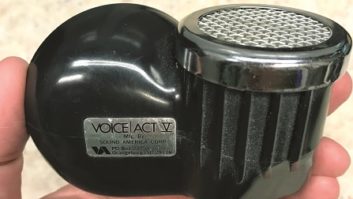
How are trends in audio codec technology playing out at a major-market radio news operation?
Brian Oliger, CBT, CBNE, is technology manager for Hubbard Radio’s news station WTOP in Washington, D.C., where he has worked since 1999. He has extensive experience in radio and digital news content creation, management and distribution systems, broadcast IT, and studio and newsroom systems. We talked with him for the ebook “Trends in Codecs 2024.”
Radio World: Brian we’re asking our interviewees what they consider the most important recent trend in broadcast codecs and related transport and networking.
Brian Oliger: For us at WTOP, the most significant development has been combining multiple hardware codecs —or “instances” — into one physical box such as the Comrex Access Multirack. Besides saving valuable rack space, it allows the codecs to share resources such as the network connection, the user interface dashboard or GUI, power connection and, using AES67, the audio connection.
Sharing the same GUI is particularly convenient in a situation in which multiple codecs are required for the same event. An example of this is live sports, in which codecs are needed for play-by-play, perhaps separate nat sound, a feed to the arena concourse and the feed to the satellite provider.
Having all these codecs visible in the same GUI allows the producer to switch easily among them to make or drop connections, monitor network conditions and audio levels and change codec profiles as needed. Hand in hand with that is support for AES67.
RW: Have you done a recent installation that was notable? How did it go?
Oliger: We purchased, installed and configured three Multirack codecs to replace an entire rack of Access Rack codecs. This was notable for us because it was my first experience working with AES67 and configuring those devices to integrate with our Wheatnet system, and configuring Wheatnet to work with them.
We encountered a few challenges, such as how to route a mono bus-minus signal in Wheatnet to a stereo AES67 device, and others. It took a little creativity and taught me a lot about AES67. Kudos to the team at Comrex for creating a straightforward “How To” guide and to Wheatstone support for answering my questions quickly and thoroughly as they came up during the deployment.
The best projects are the ones that teach you something along the way, and this was definitely one of those.
RW: What long-lasting changes did the pandemic bring, given the dramatic impact it had on radio at the time?
Oliger: Because we simply didn’t have enough hardware codecs to supply all of our talent working remotely, we learned the value of software products, especially SIP-based codecs like Linphone and smartphone apps like Comrex’s FieldTap. These products let us inexpensively outfit many more people working remotely than we otherwise would have been able to, and we still use them in several situations today. Configured properly, Linphone sounds perfectly adequate and is nearly indistinguishable from a hardware codec to everyday listeners on the air.
RW: How do today’s codecs integrate with today’s AoIP networks and infrastructures?
Oliger: Codecs that work with standard AES or analog audio are essentially plug-and-play and integrate easily into any AoIP system, but integrating an AES67 codec can be more challenging. It requires compatible timing with Precision Time Protocol v2, proper packet rate support, Session Description Protocol (SDP) data and more. However, once properly configured, AES67 audio from a codec is reliable and robust and sounds perfect. In most cases the codec manufacturer will provide instructions on how to integrate their AES67 product with the most popular AoIP systems.
RW: What codecs or apps do you use for news work?
Oliger: Our field reporters use Comrex Access hardware codecs, plus occasionally the Linphone softphone app —which communicates with our Comrex codecs on the backend using SIP — and the Comrex FieldTap app. In breaking news situations when reporters need to connect quickly and move around on a moment’s notice, the FieldTap app is their preferred choice because it makes connecting to our Comrex codecs as easy as making a phone call on their smartphone. The audio quality is “good” but not “great” compared to a hardware codec, but the tradeoff for extreme portability and ease of use is well worth it.
In more permanent remote installations, such as our studio in the House of Representatives Radio-TV Gallery on Capitol Hill, we use a Comrex BricLink II with a “nailed-up” connection over a simple Virtual Private LAN Service or VPLS from a telco vendor. That works quite well.
Our weather partners at WJLA TV here in Washington have two Comrex portable codecs set up in different locations at their studios, so their meteorologists can easily go live or file pre-recorded weather forecasts from the most convenient location. Each of those portable codecs connects to a dedicated partner codec in our TOC. The separate outputs of those are combined in a software Utility Mixer in one of our Wheatstone blades, which then appear as a single source on a fader in the consoles in our main studios. In that way, our news anchors don’t need to know or care which broadcast position the meteorologist at WJLA is actually using.
RW: Are ISDN and T1, for all intents, fully sunsetted?
Oliger: Here in Washington, ISDN is essentially fully retired. The main telco provider, Verizon, doesn’t install new ISDN lines anymore and, at least in our experience as of a few years ago, won’t repair them anymore either. When we moved and built out new studios and newsrooms about five years ago, we abandoned ISDN completely.
T1 is still a valid technology but is clearly nearing end of life. We just canceled our last three T1 circuits for audio in favor of a small VPLS network tying together a few of our remote locations. Now, together with one of our vendors, we’re in the process of implementing SDWAN technology to tie together most of our locations: studios, backup/disaster recovery, and transmitter sites.
RW: What misconceptions do many people have about codecs that you’d like to dispel?
Oliger: Among our non-technical staff, when audio problems occur while using codecs — dropouts, audio issues, etc. — their first reaction is to blame the codec, when 99.9% of the time the true problem is poor internet quality on the remote end. So for us it’s not uncommon to have to explain to people that the codec itself is working fine, but it relies upon and assumes a good quality internet connection.
The analogy I use is driving a car: As a driver, you rely upon and assume the engine is in good working order, but if the car conks out, it usually isn’t fair to call the operator a lousy driver.
Codec manufacturers have come a long way in trying to minimize or overcome connection issues internally with various technologies. At the end of the day you still need a fairly reliable data stream from Point A to Point B.
[Read the ebook “Trends in Codecs 2024.”]












